

Jeff Hawkins: How brain science will change computing. Christopher deCharms: A look inside the brain in real time. Rebecca Saxe: How we read each other's minds. Neil Burgess: How your brain tells you where you are. Sandrine Thuret: You can grow new brain cells. Here's how. Ed Boyden: Baby diapers inspired this new way to study the brain. This new brain map shows almost 100 areas never described before. You don’t have to be a neurosurgeon to know it’s hard to get to the right place without a good map.

But neuroscientists have been blundering around with blurry brain maps, which sometimes aren’t very detailed, or omit important functions. That’s why a new map is so exciting — it shows nearly 100 areas that hadn’t been reported before. The map, described in a study published today in Nature, is a detailed look at the part of the brain that handles all your senses, as well as your motion — plus some other functions like problem solving and emotional regulation. New Method of High-Resolution Whole-Brain Staining. A new staining method closes one of the last methodological gaps: Now it’s possible to map every nerve cell and its synapses in a mouse brain.
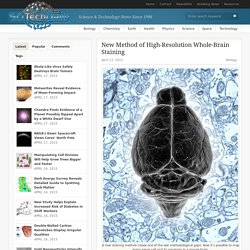
Researchers from the Max Planck Institute of Neurobiology have developed a special staining method that brings the reconstruction of all nerve cells and their connections within reach. Learning, it is widely believed is based on changes in the connections between nerve cells. From decisions to disorders: how neuroscience is changing what we know about ourselves. People have wanted to understand our motivations, thoughts and behaviours since the ancient Greeks inscribed “know thyself” on the Temple of Apollo at Delphi.
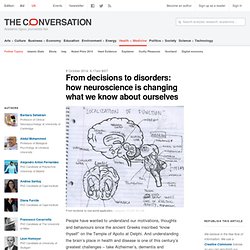
And understanding the brain’s place in health and disease is one of this century’s greatest challenges – take Alzheimer’s, dementia and depression for example. There are many exciting contributions from neuroscience that have given insight into our thoughts and actions. Three neuroscientists have just been awarded the 2014 Nobel Prize for their discoveries of cells that act as a positioning system in the brain – in other words, the mechanism that allows us to navigate spaces using spatial information and memory at a cellular level. There are many exciting contributions from neuroscience that have given insight into our thoughts and actions. For example, the neural basis of how we make fast and slow decisions and decision-making under conditions of uncertainty. Neuroscience can challenge previously accepted views. Click to enlarge. Brain and Brain: What is Brain? : Robert Hampson, Neuroscience.
It's a classic line, from Star Trek: The Original Series episode "Spock's Brain", in which we discover that if you just connect the vocal chords, the patient can direct you in connecting the rest of the nerves!

To introduce this forum and the brain science topics supporting Escaping Titan, it is necessary to discuss a little bit of the brain's structure. I usually use this picture or one like it to introduce the structure of the brain – either that, or I tell people to hold their right hand at arm's length in front of their face, fingers together, palm flat and facing directly away from the face. Glee for Glia. Marijuana affects memory… through astrocytes!
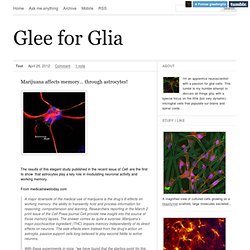
The results of this elegant study published in the recent issue of Cell are the first to show that astrocytes play a key role in modulating neuronal activity and working memory. From medicalnewstoday.com A major downside of the medical use of marijuana is the drug’s ill effects on working memory, the ability to transiently hold and process information for reasoning, comprehension and learning. Lab-Grown Model Brains. Cross-section of cerebral organoid; All cells in blue, neural stem cells in red, and neurons in green.
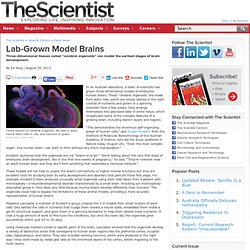
MADELINE A. LANCASTERIn an Austrian laboratory, a team of scientists has grown three-dimensional models of embryonic human brains. These “cerebral organoids” are made from stem cells, which are simply bathed in the right cocktail of nutrients and grown in a spinning chamber. Over a few weeks, they arrange themselves into pea-sized balls of white tissue, which recapitulate some of the complex features of a growing brain, including distinct layers and regions. “This demonstrates the enormous self-organizing power of human cells,” said Jürgen Knoblich from the Institute of Molecular Biotechnology of the Austrian Academy of Science, who led the study published in Nature today (August 28). A Neuroscientist's Radical Theory of How Networks Become Conscious - Wired Science. It’s a question that’s perplexed philosophers for centuries and scientists for decades: Where does consciousness come from?
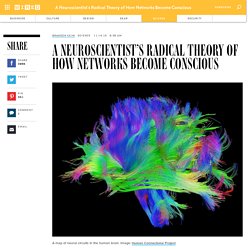
We know it exists, at least in ourselves. But how it arises from chemistry and electricity in our brains is an unsolved mystery. Neuroscientist Christof Koch, chief scientific officer at the Allen Institute for Brain Science, thinks he might know the answer. According to Koch, consciousness arises within any sufficiently complex, information-processing system. All animals, from humans on down to earthworms, are conscious; even the internet could be. “The electric charge of an electron doesn’t arise out of more elemental properties. Left Brain vs Right Brain and Other Myths About the Brain.
New tasks become as simple as waving a hand with brain-computer interfaces. Small electrodes placed on or inside the brain allow patients to interact with computers or control robotic limbs simply by thinking about how to execute those actions.
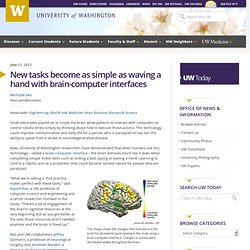
This technology could improve communication and daily life for a person who is paralyzed or has lost the ability to speak from a stroke or neurodegenerative disease. Now, University of Washington researchers have demonstrated that when humans use this technology – called a brain-computer interface – the brain behaves much like it does when completing simple motor skills such as kicking a ball, typing or waving a hand. Learning to control a robotic arm or a prosthetic limb could become second nature for people who are paralyzed. High resolutionClick to expand Jeremiah Wander, UW. Project Seeks to Build Map of Human Brain. Henry Markram: A brain in a supercomputer. A Healthy Nervous System: A Delicate Balance.
Search current video 1.
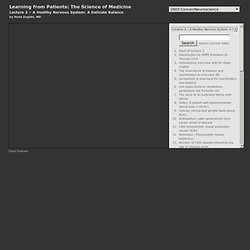
Start of Lecture 3 2. Introduction by HHMI President Dr. Thomas Cech 3. Introductory interview with Dr. Brain might not stand in the way of free will. Social Network Size Linked to Brain Size. Do Thrifty Brains Make Better Minds? Two glasses of wine a day can nearly HALVE the number of brain cells we produce. Even moderate drinking can decrease the production of adult brain cells by as much as 40 per centLong term effects included impaired memory Another study finds resveratrol supplements, based on red wine, may not help prevent disease By Anna Hodgekiss Published: 16:27 GMT, 25 October 2012 | Updated: 16:03 GMT, 26 October 2012 Even moderate drinking can decrease the production of adult brain cells by as much as 40 per cent.
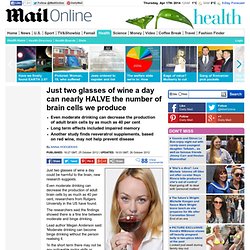
Plan of Action: How the Spinal Cord Controls Movement. Building Brains: The Molecular Logic of Neural Circuits. Brain Atlas - Introduction. The central nervous system (CNS) consists of the brain and the spinal cord, immersed in the cerebrospinal fluid (CSF). Weighing about 3 pounds (1.4 kilograms), the brain consists of three main structures: the cerebrum, the cerebellum and the brainstem. Cerebrum - divided into two hemispheres (left and right), each consists of four lobes (frontal, parietal, occipital and temporal). Brain's Hidden Sewers Revealed - Science News. Top 10 Mysteries of the Mind. By Jeanna Bryner, Live Science Managing Editor | October 09, 2007 01:25pm ET Credit: NIH, NIDA Much of what we don't understand about being human is simply in our heads.
The brain is a befuddling organ, as are the very questions of life and death, consciousness, sleep, and much more. Here's a heads-up on what's known and what's not understood about your noggin. Author Bio Jeanna Bryner Before becoming managing editor, Jeanna served as a reporter for Live Science and SPACE.com for about three years. The Power of Karate Comes From the Brain. The Brain in Technicolour.
Probing the Brain's Mysteries. World's First Whole-Brain Wiring Diagram Takes Step Forward. A Countdown to a Digital Simulation of Every Last Neuron in the Human Brain. How exactly do neurons pass signals through your nervous system? How Your Brain Experiences the Passage of Time.
Science News. The Sentis Brain Animation Series - The Regions of the Brain. Scientists Discover How the Brain Creates Meaning. Which Direction Now? Just Ask the North-facing Map in Your Head - Association for Psychological Science. BRAIN POWER: From Neurons to Networks. Prediction Errors Make Us More Optimistic. Neuroscientists identify a brain region that can switch between new and old habits. [VIDEO] Platforms for the Future: Decoding the Brain - Dustin Stansbury. Genetic Study Offers Clues to How Intelligence Changes Through Life. How Neuroscience Is Shrinking Our Concept of Consciousness. Alltop - Top Neuroscience News. Why Some People See Sound. Neuroplasticity. Books Trim the Brain.
Flip of a single molecular switch makes an old brain young. A cultured neuron with projecting dendrites studded with sites of communication between neurons, known as dendritic spines. The flip of a single molecular switch helps create the mature neuronal connections that allow the brain to bridge the gap between adolescent impressionability and adult stability. Now Yale School of Medicine researchers have reversed the process, recreating a youthful brain that facilitated both learning and healing in the adult mouse. Scientists have long known that the young and old brains are very different. Adolescent brains are more malleable or plastic, which allows them to learn languages more quickly than adults and speeds recovery from brain injuries.
Nogo Proteins & Receptors. Discovered as the molecules that block axon regeneration following injury, Nogo proteins are one of the most potent neurite growth inhibitors in the CNS. Nogo proteins function as negative regulators during development and serve as stabilizers of neuronal wiring in adult brain. A member of the Reticulon (RTN) family, alternative splicing and differential promoter usage results in the generation of three protein products (Nogo-A, -B, and -C) from a single gene (RTN4/NOGO).
The inhibitory actions of Nogo-A are dependent on two domains, Nogo-66 which is present in all three isoforms, and a sequence referred to as Nogo-delta 20, that is unique to the long N-terminal domain of Nogo-A. Nogo-A exerts its effects by binding to Nogo Receptor 1 (NgR1), via the Nogo-66 domain. Nogo receptor 1 regulates formation... [Proc Natl Acad Sci U S A. 2009. Neuron - Anatomical Plasticity of Adult Brain Is Titrated by Nogo Receptor 1. To view the full text, please login as a subscribed user or purchase a subscription. Click here to view the full text on ScienceDirect.
Neuron, Volume 77, Issue 5 , 859-866, 6 March 2013 Copyright © 2013 Elsevier Inc. All rights reserved. 10.1016/j.neuron.2012.12.027. The brain organizes objects based on their physical size. How to Think About the Mind. [VIDEO] - How the Brain's Wiring Forms Thoughts and Emotions. Video: Brain Nerves Look Like City Streets. The Whole Brain Atlas. Multiple thought channels may help brain avoid traffic jams. Language is shaped by brain's desire for clarity and ease.
Neuroscience, teaching, psychology and education (Mind, Brain, and Education science) Mind transfer. Brain's wiring: More like the Internet than a pyramid? Science News. The brain… it makes you think. Doesn't it? When people worry about math, the brain feels the pain. Where categories live in the brain. Something on Your Mind? The Brain Decides… A selective magnetic zap can alter belief formation in our brains. Does the size of our social network correlate with brain growth. Your Brain by the Numbers.